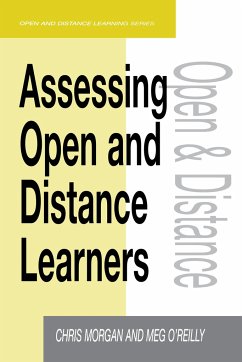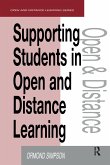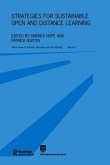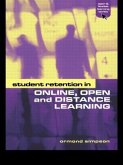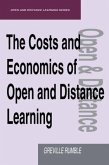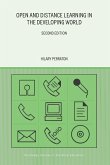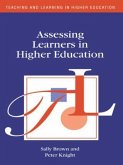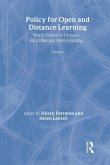- Broschiertes Buch
- Merkliste
- Auf die Merkliste
- Bewerten Bewerten
- Teilen
- Produkt teilen
- Produkterinnerung
- Produkterinnerung
Research has indicated that assessment is a key factor in student learning. This book details the issues of assessment in the open and distance learning field, where changes in budgets, the location and environment of the students and other factors have prompted innovations in assessment.
Andere Kunden interessierten sich auch für
![Supporting Students in Online Open and Distance Learning Supporting Students in Online Open and Distance Learning]() Ormond SimpsonSupporting Students in Online Open and Distance Learning71,99 €
Ormond SimpsonSupporting Students in Online Open and Distance Learning71,99 €![Strategies for Sustainable Open and Distance Learning Strategies for Sustainable Open and Distance Learning]() Andrea Hope / Patrick GuitonStrategies for Sustainable Open and Distance Learning62,99 €
Andrea Hope / Patrick GuitonStrategies for Sustainable Open and Distance Learning62,99 €![Student Retention in Online, Open and Distance Learning Student Retention in Online, Open and Distance Learning]() Ormond SimpsonStudent Retention in Online, Open and Distance Learning76,99 €
Ormond SimpsonStudent Retention in Online, Open and Distance Learning76,99 €![The Costs and Economics of Open and Distance Learning The Costs and Economics of Open and Distance Learning]() Greville Rumble (Lecturer Open UniversThe Costs and Economics of Open and Distance Learning71,99 €
Greville Rumble (Lecturer Open UniversThe Costs and Economics of Open and Distance Learning71,99 €![Open and Distance Learning in the Developing World Open and Distance Learning in the Developing World]() Hilary PerratonOpen and Distance Learning in the Developing World32,99 €
Hilary PerratonOpen and Distance Learning in the Developing World32,99 €![Assessing Learners in Higher Education Assessing Learners in Higher Education]() Sally BrownAssessing Learners in Higher Education29,99 €
Sally BrownAssessing Learners in Higher Education29,99 €![Policy for Open and Distance Learning Policy for Open and Distance Learning]() Helen Lentell / Hilary Perraton (eds.)Policy for Open and Distance Learning90,99 €
Helen Lentell / Hilary Perraton (eds.)Policy for Open and Distance Learning90,99 €-
-
-
Research has indicated that assessment is a key factor in student learning. This book details the issues of assessment in the open and distance learning field, where changes in budgets, the location and environment of the students and other factors have prompted innovations in assessment.
Hinweis: Dieser Artikel kann nur an eine deutsche Lieferadresse ausgeliefert werden.
Hinweis: Dieser Artikel kann nur an eine deutsche Lieferadresse ausgeliefert werden.
Produktdetails
- Produktdetails
- Verlag: Routledge
- Seitenzahl: 242
- Erscheinungstermin: 1. November 1999
- Englisch
- Abmessung: 234mm x 156mm x 13mm
- Gewicht: 374g
- ISBN-13: 9780749428785
- ISBN-10: 0749428783
- Artikelnr.: 20958822
- Herstellerkennzeichnung
- Libri GmbH
- Europaallee 1
- 36244 Bad Hersfeld
- gpsr@libri.de
- Verlag: Routledge
- Seitenzahl: 242
- Erscheinungstermin: 1. November 1999
- Englisch
- Abmessung: 234mm x 156mm x 13mm
- Gewicht: 374g
- ISBN-13: 9780749428785
- ISBN-10: 0749428783
- Artikelnr.: 20958822
- Herstellerkennzeichnung
- Libri GmbH
- Europaallee 1
- 36244 Bad Hersfeld
- gpsr@libri.de
Chris Morgan is lecturer and educational designers in the Teaching and Learning Centre at Southern Cross University, Australia. They work closely with academic and industry-based specialists to establish and ensure quality in open, distance and flexible learning programmes. Meg O'Reilly is lecturer and educational designers in the Teaching and Learning Centre at Southern Cross University, Australia. They work closely with academic and industry-based specialists to establish and ensure quality in open, distance and flexible learning programmes.
Series editor's foreword
Acknowledgements
Introduction
Part A: Issues and themes in open and distance assessment
1. Thinking about assessment
Negative themes
Positive themes
Making sense of our reflections
2. Key issues and terms in assessment
Explaining assessment
Purposes of assessment: formative and summative
Assessment: whose needs?
Assessment and the learning context
The grading game: norm and criterion referenced assessment
3. Assessment in open and distance contexts
Introduction
Open and distance learners' approaches to assessment
Opportunities for assessment in open and distance learning
Assessment and 'distance'
Assessment and 'openness'
Tensions in open and distance assessment
Key qualities of open and distance assessment
4. Online technologies in open and distance assessment
Introduction
Opportunities presented by online learning and assessment
Potential losses
Reconceptualizing our pedagogy
Part B: Assessing learners in open and distance learning
5. Designing assessment tasks
Introduction
Aligning assessment with objectives Selecting methods of assessment
Which assessment methods are appropriate for open and distance learning?
How much assessment is sufficient?
How long should an assessment be?
How should the assessments be spaced?
What value should be placed on each item?
Is the assessment practicable?
Are your assessments valid and reliable?
Are your assessment tasks authentic?
Are your assessments open and inclusive?
Conclusion
Designing assessment tasks
at a glance Further resources
6. Communicating assessment tasks
Communicating sufficient and clear information
Developing marking criteria
Moderating assessment tasks
7. Marking and grading
Introduction
Marking practices
Feedback on assignments
Marking turnaround time
Awarding grades
Authentication
8. Creating dialogue through assessment
Facilitating dialogue in open and distance learning
Making contact
Communicating empathetically
Communication breakdown
Encouraging self
management and self
direction
Developing communities of learners
Mentoring
Conclusion
9. Managing time
Finding the time to make change
Managing an assessment load Supporting learners to manage their time
10. Developing assessment policies
Whole
of
course approach to assessment Student appeal procedures
Extensions to assignments and special consideration
Marking practices
Plagiarism
11. Evaluating your assessment practices
Evaluation in open and distance settings
Purposes of evaluating assessment
Types and methods of evaluation
Conclusion
Part C: Case studies
1. Thinking critically and making judgements
1.1 Think
aloud protocols
1.2 Discussion among learners
1.3 Diary to the teacher
1.4 Analytical thinking
2. Solving problems and developing plans
2.1 Collaborative decision making and clinical problem solving
2.2 Creative problem solving and constructive autonomy
2.3 Integrated planning project
2.4 Developing consulting skills
3. Performing procedures and demonstrating techniques
3.1 Developing expertise in neonatal resuscitation
3.2 Dissecting rats and providing evidence
3.3 Developing competences in writing research proposals
4. Managing and developing oneself
4.1 Contract for personal change
4.2 Participation in open learning
4.3 Becoming an OZKidsConnect volunteer
4.4 Whole
of
course portfolio
5. Accessing and managing information
5.1 Delivering a scientific research paper to an audience of peers
5.2 Sharing development and discussion of case study method
5.3 Presenting an exhibit at an arts conference
5.4 Writing a proposal, researching and reporting findings
6. Demonstrating knowledge and understanding
6.1 Testing knowledge using online multiple choice quizzes
6.2 Reasoning and logic
6.3 Simultaneous off
and on
campus multiple choice tests
6.4 Mathematics self
assessment on CD ROM
7. Designing, creating, performing
7.1 Designing online training
7.2 Video report of artistic development in ceramics
7.3 Conference and Web site for a science community
7.4 Creating and appreciating photographic expression
8. Communicating
8.1 Oral communication and audiotape interview
8.2 Computer conferencing
8.3 International debate
8.4 Online collaboration
Appendix A Terms commonly used in assessment
Appendix B Sample marking guide
Appendix C Clinical competence assessment criteria
References
Index.
Acknowledgements
Introduction
Part A: Issues and themes in open and distance assessment
1. Thinking about assessment
Negative themes
Positive themes
Making sense of our reflections
2. Key issues and terms in assessment
Explaining assessment
Purposes of assessment: formative and summative
Assessment: whose needs?
Assessment and the learning context
The grading game: norm and criterion referenced assessment
3. Assessment in open and distance contexts
Introduction
Open and distance learners' approaches to assessment
Opportunities for assessment in open and distance learning
Assessment and 'distance'
Assessment and 'openness'
Tensions in open and distance assessment
Key qualities of open and distance assessment
4. Online technologies in open and distance assessment
Introduction
Opportunities presented by online learning and assessment
Potential losses
Reconceptualizing our pedagogy
Part B: Assessing learners in open and distance learning
5. Designing assessment tasks
Introduction
Aligning assessment with objectives Selecting methods of assessment
Which assessment methods are appropriate for open and distance learning?
How much assessment is sufficient?
How long should an assessment be?
How should the assessments be spaced?
What value should be placed on each item?
Is the assessment practicable?
Are your assessments valid and reliable?
Are your assessment tasks authentic?
Are your assessments open and inclusive?
Conclusion
Designing assessment tasks
at a glance Further resources
6. Communicating assessment tasks
Communicating sufficient and clear information
Developing marking criteria
Moderating assessment tasks
7. Marking and grading
Introduction
Marking practices
Feedback on assignments
Marking turnaround time
Awarding grades
Authentication
8. Creating dialogue through assessment
Facilitating dialogue in open and distance learning
Making contact
Communicating empathetically
Communication breakdown
Encouraging self
management and self
direction
Developing communities of learners
Mentoring
Conclusion
9. Managing time
Finding the time to make change
Managing an assessment load Supporting learners to manage their time
10. Developing assessment policies
Whole
of
course approach to assessment Student appeal procedures
Extensions to assignments and special consideration
Marking practices
Plagiarism
11. Evaluating your assessment practices
Evaluation in open and distance settings
Purposes of evaluating assessment
Types and methods of evaluation
Conclusion
Part C: Case studies
1. Thinking critically and making judgements
1.1 Think
aloud protocols
1.2 Discussion among learners
1.3 Diary to the teacher
1.4 Analytical thinking
2. Solving problems and developing plans
2.1 Collaborative decision making and clinical problem solving
2.2 Creative problem solving and constructive autonomy
2.3 Integrated planning project
2.4 Developing consulting skills
3. Performing procedures and demonstrating techniques
3.1 Developing expertise in neonatal resuscitation
3.2 Dissecting rats and providing evidence
3.3 Developing competences in writing research proposals
4. Managing and developing oneself
4.1 Contract for personal change
4.2 Participation in open learning
4.3 Becoming an OZKidsConnect volunteer
4.4 Whole
of
course portfolio
5. Accessing and managing information
5.1 Delivering a scientific research paper to an audience of peers
5.2 Sharing development and discussion of case study method
5.3 Presenting an exhibit at an arts conference
5.4 Writing a proposal, researching and reporting findings
6. Demonstrating knowledge and understanding
6.1 Testing knowledge using online multiple choice quizzes
6.2 Reasoning and logic
6.3 Simultaneous off
and on
campus multiple choice tests
6.4 Mathematics self
assessment on CD ROM
7. Designing, creating, performing
7.1 Designing online training
7.2 Video report of artistic development in ceramics
7.3 Conference and Web site for a science community
7.4 Creating and appreciating photographic expression
8. Communicating
8.1 Oral communication and audiotape interview
8.2 Computer conferencing
8.3 International debate
8.4 Online collaboration
Appendix A Terms commonly used in assessment
Appendix B Sample marking guide
Appendix C Clinical competence assessment criteria
References
Index.
Series editor's foreword
Acknowledgements
Introduction
Part A: Issues and themes in open and distance assessment
1. Thinking about assessment
Negative themes
Positive themes
Making sense of our reflections
2. Key issues and terms in assessment
Explaining assessment
Purposes of assessment: formative and summative
Assessment: whose needs?
Assessment and the learning context
The grading game: norm and criterion referenced assessment
3. Assessment in open and distance contexts
Introduction
Open and distance learners' approaches to assessment
Opportunities for assessment in open and distance learning
Assessment and 'distance'
Assessment and 'openness'
Tensions in open and distance assessment
Key qualities of open and distance assessment
4. Online technologies in open and distance assessment
Introduction
Opportunities presented by online learning and assessment
Potential losses
Reconceptualizing our pedagogy
Part B: Assessing learners in open and distance learning
5. Designing assessment tasks
Introduction
Aligning assessment with objectives Selecting methods of assessment
Which assessment methods are appropriate for open and distance learning?
How much assessment is sufficient?
How long should an assessment be?
How should the assessments be spaced?
What value should be placed on each item?
Is the assessment practicable?
Are your assessments valid and reliable?
Are your assessment tasks authentic?
Are your assessments open and inclusive?
Conclusion
Designing assessment tasks
at a glance Further resources
6. Communicating assessment tasks
Communicating sufficient and clear information
Developing marking criteria
Moderating assessment tasks
7. Marking and grading
Introduction
Marking practices
Feedback on assignments
Marking turnaround time
Awarding grades
Authentication
8. Creating dialogue through assessment
Facilitating dialogue in open and distance learning
Making contact
Communicating empathetically
Communication breakdown
Encouraging self
management and self
direction
Developing communities of learners
Mentoring
Conclusion
9. Managing time
Finding the time to make change
Managing an assessment load Supporting learners to manage their time
10. Developing assessment policies
Whole
of
course approach to assessment Student appeal procedures
Extensions to assignments and special consideration
Marking practices
Plagiarism
11. Evaluating your assessment practices
Evaluation in open and distance settings
Purposes of evaluating assessment
Types and methods of evaluation
Conclusion
Part C: Case studies
1. Thinking critically and making judgements
1.1 Think
aloud protocols
1.2 Discussion among learners
1.3 Diary to the teacher
1.4 Analytical thinking
2. Solving problems and developing plans
2.1 Collaborative decision making and clinical problem solving
2.2 Creative problem solving and constructive autonomy
2.3 Integrated planning project
2.4 Developing consulting skills
3. Performing procedures and demonstrating techniques
3.1 Developing expertise in neonatal resuscitation
3.2 Dissecting rats and providing evidence
3.3 Developing competences in writing research proposals
4. Managing and developing oneself
4.1 Contract for personal change
4.2 Participation in open learning
4.3 Becoming an OZKidsConnect volunteer
4.4 Whole
of
course portfolio
5. Accessing and managing information
5.1 Delivering a scientific research paper to an audience of peers
5.2 Sharing development and discussion of case study method
5.3 Presenting an exhibit at an arts conference
5.4 Writing a proposal, researching and reporting findings
6. Demonstrating knowledge and understanding
6.1 Testing knowledge using online multiple choice quizzes
6.2 Reasoning and logic
6.3 Simultaneous off
and on
campus multiple choice tests
6.4 Mathematics self
assessment on CD ROM
7. Designing, creating, performing
7.1 Designing online training
7.2 Video report of artistic development in ceramics
7.3 Conference and Web site for a science community
7.4 Creating and appreciating photographic expression
8. Communicating
8.1 Oral communication and audiotape interview
8.2 Computer conferencing
8.3 International debate
8.4 Online collaboration
Appendix A Terms commonly used in assessment
Appendix B Sample marking guide
Appendix C Clinical competence assessment criteria
References
Index.
Acknowledgements
Introduction
Part A: Issues and themes in open and distance assessment
1. Thinking about assessment
Negative themes
Positive themes
Making sense of our reflections
2. Key issues and terms in assessment
Explaining assessment
Purposes of assessment: formative and summative
Assessment: whose needs?
Assessment and the learning context
The grading game: norm and criterion referenced assessment
3. Assessment in open and distance contexts
Introduction
Open and distance learners' approaches to assessment
Opportunities for assessment in open and distance learning
Assessment and 'distance'
Assessment and 'openness'
Tensions in open and distance assessment
Key qualities of open and distance assessment
4. Online technologies in open and distance assessment
Introduction
Opportunities presented by online learning and assessment
Potential losses
Reconceptualizing our pedagogy
Part B: Assessing learners in open and distance learning
5. Designing assessment tasks
Introduction
Aligning assessment with objectives Selecting methods of assessment
Which assessment methods are appropriate for open and distance learning?
How much assessment is sufficient?
How long should an assessment be?
How should the assessments be spaced?
What value should be placed on each item?
Is the assessment practicable?
Are your assessments valid and reliable?
Are your assessment tasks authentic?
Are your assessments open and inclusive?
Conclusion
Designing assessment tasks
at a glance Further resources
6. Communicating assessment tasks
Communicating sufficient and clear information
Developing marking criteria
Moderating assessment tasks
7. Marking and grading
Introduction
Marking practices
Feedback on assignments
Marking turnaround time
Awarding grades
Authentication
8. Creating dialogue through assessment
Facilitating dialogue in open and distance learning
Making contact
Communicating empathetically
Communication breakdown
Encouraging self
management and self
direction
Developing communities of learners
Mentoring
Conclusion
9. Managing time
Finding the time to make change
Managing an assessment load Supporting learners to manage their time
10. Developing assessment policies
Whole
of
course approach to assessment Student appeal procedures
Extensions to assignments and special consideration
Marking practices
Plagiarism
11. Evaluating your assessment practices
Evaluation in open and distance settings
Purposes of evaluating assessment
Types and methods of evaluation
Conclusion
Part C: Case studies
1. Thinking critically and making judgements
1.1 Think
aloud protocols
1.2 Discussion among learners
1.3 Diary to the teacher
1.4 Analytical thinking
2. Solving problems and developing plans
2.1 Collaborative decision making and clinical problem solving
2.2 Creative problem solving and constructive autonomy
2.3 Integrated planning project
2.4 Developing consulting skills
3. Performing procedures and demonstrating techniques
3.1 Developing expertise in neonatal resuscitation
3.2 Dissecting rats and providing evidence
3.3 Developing competences in writing research proposals
4. Managing and developing oneself
4.1 Contract for personal change
4.2 Participation in open learning
4.3 Becoming an OZKidsConnect volunteer
4.4 Whole
of
course portfolio
5. Accessing and managing information
5.1 Delivering a scientific research paper to an audience of peers
5.2 Sharing development and discussion of case study method
5.3 Presenting an exhibit at an arts conference
5.4 Writing a proposal, researching and reporting findings
6. Demonstrating knowledge and understanding
6.1 Testing knowledge using online multiple choice quizzes
6.2 Reasoning and logic
6.3 Simultaneous off
and on
campus multiple choice tests
6.4 Mathematics self
assessment on CD ROM
7. Designing, creating, performing
7.1 Designing online training
7.2 Video report of artistic development in ceramics
7.3 Conference and Web site for a science community
7.4 Creating and appreciating photographic expression
8. Communicating
8.1 Oral communication and audiotape interview
8.2 Computer conferencing
8.3 International debate
8.4 Online collaboration
Appendix A Terms commonly used in assessment
Appendix B Sample marking guide
Appendix C Clinical competence assessment criteria
References
Index.

